6. Marketing in the Facebook Era
“Facebook advertising doesn’t feel like advertising because it comes from your friends.”
—Tim Kendall, director of monetization at Facebook
Marketers need to be where the customers are, and, increasingly, customers are on social networking sites. This very moment, nearly a billion people (that is, most of the Internet population) around the world are logged on to a social networking site, updating their status, interacting with friends, interacting with companies, providing valuable information for you to understand them better, and learning about you in return (see Figure 6.1). Remarkably, the average Facebook user spends nearly a full hour per day on the site, according to official company data.
Figure 6.1
Social network profiles and status messages, such as this one on Facebook, are rich sources of information for companies to learn from customers, generate leads, and interact with fans.

Before launching into execution mode, marketers need to grasp how the social Web affects underlying audience dynamics. This chapter is about the new rules and strategies governing social network marketing, including hypertargeting, social word-of-mouth, and customer engagement, with a discussion at the end on challenges and limitations in this space. Chapters 11, “How To: Engage Customers with Facebook Pages and Twitter,” and 12, “How To: Advertise and Promote on the Social Web,” discuss the tactical ins and outs of Twitter, Facebook Pages, and Facebook ads, which are based off these principles.
The New Rules of Marketing
The same old marketing strategies don’t work anymore—the medium has evolved. The marketplace for nearly every product or service is extremely crowded—it’s never been harder for companies to differentiate their offerings. Meanwhile, in the wake of corporate scandals, product recalls, and the mortgage-backed securities crisis, consumer opinion has never been more skeptical of business. More than ever, people trust their friends the most. Social networks are emerging as a powerful new marketing channel for companies to hypertarget campaigns using profile information, engage community members by tapping into transitive trust within friend groups, and systematically cultivate word-of-mouth across their existing customer base.
Social network marketing requires a new strategy and tactics that take advantage of the unique features and capabilities of the social Web. Just as marketers had to learn email and Web marketing a decade ago, today they have to master Twitter and Facebook. Academic institutions such as Berkeley, Georgetown, Southern New Hampshire University, and dozens of others have begun offering courses and even entire degree programs focused on social media marketing. Companies of all sizes and industries are beginning to find utility in Facebook and Twitter across the marketing funnel (see Figure 6.2).
Figure 6.2
You can use social networking sites such as Facebook and Twitter across the marketing funnel.
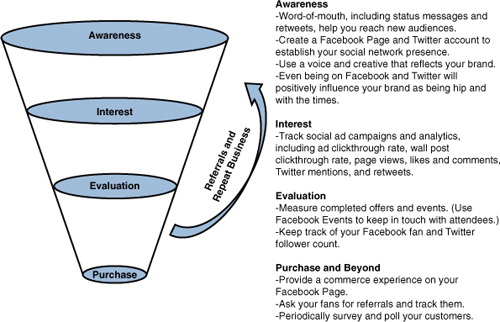
Why are social networks so effective for marketing? When people log on to a social networking site, they feel they are among friends. From status updates to birthday reminders, the content they see is tailored just for them. The highly personalized experience exudes trust.
Social network advertisers are, in effect, given access to a direct, customized portal for each individual audience member. The challenge has been that although advertisers might be catching their audience in a more trusting mind-set, social networking sites thus far have largely been about communication, not purchase intent. The question remains whether high context from friend and profile data will be able to overcome low purchase intent, or whether social networks will be able to successfully incorporate (or be incorporated into) high-intent online marketplaces, searches, and product comparison sites.
Hypertargeting
“Half the money I spend on advertising is wasted; the trouble is, I don’t know which half.”
—John Wanamaker, department store merchant
John Wanamaker’s famous saying seems to ring as true today as it did 100 years ago. But especially as budgets are getting squeezed, more advertisers are saying that enough is enough. As tools and technologies for tracking campaigns have improved, we are seeing a fundamental shift in the online advertising industry toward performance marketing. With the exception, perhaps, of the biggest brands, advertisers increasingly are willing to pay for only hard-and-fast results.
Hypertargeting (also called microtargeting), the capability on social networking sites to target ads based on very specific criteria, is an important step toward precision marketing. Facebook and LinkedIn are leading the charge, with sophisticated targeting tools that enable advertisers to choose which individual profiles see their ads. Advertisers can target profiles based on filters such as location, gender, age, education, workplace, relationship status, relationship interests, and interest keywords. For example, a wedding planner might hypertarget only those whose relationship status is set to “engaged.” Or a golf retail store in Carlsbad, California, might hypertarget men of a certain age who live within a 10-mile radius and have specified “golf” as one of their hobbies. But it’s not just ads. On Facebook, Page admins can also target fan communications by location, age, and gender for updates, and location and language for Wall posts.
Hypertargeting is possible only because of what people share about themselves on social network profiles. Because of social pressure and a need for self-expression, most people reveal a lot about themselves. As we talked about in Chapter 2, “The New Social Norms,” it’s pretty standard for people to share gender, birthday, hometown, employer, college, and high school information, and it’s not unusual to share relationship status, political views, religious beliefs, activities, interests, favorite music, TV shows, movies, and books. Companies can use all this information for hypertargeting. Even certain information, such as birth year, that is hidden based on privacy settings is fair game for ad-targeting purposes. (No personally identifiable info is ever shared with advertisers.)
Hypertargeting can be equally compelling for business-to-business (B2B) sales. Naturally, B2B decision makers have social networking profiles that can be targeted and advertised to. For many products and services, recommendations and referrals from trusted friends and colleagues are important factors in deciding whether to buy. For example, a software vendor might hypertarget ads to people whose job title contains the words IT or CIO. For even greater customization and precision, the hypertargeting criteria could specify the name of the company that the vendor is trying to sell to.
When done right, hypertargeting can improve ad conversions and reduce costs because it enables marketers to 1) show ads only to people most likely to buy, 2) tailor ad campaigns to specific audiences, 3) take advantage of better campaign data, and 4) cost-effectively reach so-called passive buyers, as detailed in the following sections.
1. Don’t Waste Ads on People Who Will Never Buy
Before social network marketing, advertisers had no choice but to show ads to everyone who visited a Web page they sponsored or searched on a keyword they bought. Advertisers couldn’t turn on ads for some people and turn them off for others. This was less efficient for both search marketing and display ads because some (at times, substantial) portion of the ads that they purchased were invariably shown to and wasted on the wrong audience—people who weren’t the right age, gender, or religion, or didn’t have the right occupation, marital status, or stated interests to likely demand the product. With hypertargeting, advertisers can remove audience segments from their campaigns who are unlikely to buy or have a lower probability of buying (which equates to a lower ad return on investment [ROI]) and focus on probable buyers.
Hypertargeting Golfers
Let’s revisit the earlier example about reaching male golfers ages 40–55 in California. Previously, advertisers had no direct way to access this group. They had to access by proxy, either with brand advertising in men’s golf publications or search advertising from California IP addresses on the keyword “golf.” In either case, the targeting might be incomplete, imprecise, and potentially expensive. Some ads were wasted and demand was left on the table (see the upcoming section “Cost-Effectively Reach Passive Buyers”) because advertisers couldn’t limit who actually saw the ad.
As Figure 6.3 shows, social network hypertargeting lets advertisers minimize the number of wasted ads by targeting only the intended audience segment. Social network ads make it possible to specify who gets shown an ad.
In this example, advertisers would not show nongolfers the ad because they don’t fit the hypertargeting criteria. Likely, nongolfers would be grateful to have been spared from an ad that’s irrelevant to them. But to golf enthusiasts living near San Diego, the ad would be highly relevant. Ads that are targeted and relevant don’t feel like spam, and they are much more likely to convert viewers into customers.
Figure 6.3
It’s hard to capture the full power of hypertargeting in this two-dimensional figure, but it illustrates the basic idea. Hypertargeting lets advertisers specify an audience profile—in this case, men in California ages 40–55 who mention “golf” in their profile. No ads are wasted on anyone who does not fit all these criteria.
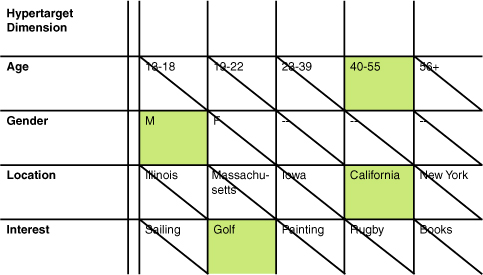
Even brand advertisers who want to reach everyone should segment audiences and pay more to advertise to higher-value segments. Both Facebook and LinkedIn sell ads via CPC (cost-per-click) or CPM (cost-per-thousand impressions) auctions, similar to most search marketing models. As a marketer, you want to bid more per view or click for audience segments that have a higher likelihood of becoming customers.
2. Tailor Ad Campaigns to Specific Audiences
Not only can advertisers cut out undesirable audience segments in their campaigns, but they can also further segment among the people they do want to target and tailor which ads are shown to whom.
Before hypertargeting, advertisers had little choice but to show the same ad to everyone. If different ads were shown, it was usually done randomly. Hypertargeting makes it possible to run very specific ad campaigns; advertisers can customize ad copy for the exact segment of individuals they are targeting. Better-tailored, more specific ads result in higher click-through rates and, ultimately, increased returns on advertising dollars spent.
Social network hypertargeting provides a new capability to “think global, act local.” Advertisers can use what they know about a particular hypersegment to make ads feel more personal. Advertisers know the exact demographic and psychographic—that is, self-ascribed preferences—attributes of the audience because the consumers have chosen the hypertargeting criteria. This enables advertisers to make their ads less about the generic features of their product and more about what’s important to the people viewing the ad.
Bonobos, an online retailer of men’s pants, uses hypertargeting to “act local.” Its ads on Facebook hypertarget audience segments based on gender, age, and stated interest in a sports team. Bonobos’ marketers use knowledge about sports team colors to determine which pant color to promote, and they tailor their ad copy accordingly. For example, men age 18 and older in the United States who have “Red Sox” in their profile are shown the ad in Figure 6.4. As you can see, the main message of the ad is not about Bonobos pants. It’s about being a loyal fan and looking good when you attend a Boston Red Sox game at Fenway Park.
Ads such as this one have done well because Bonobos is able to tap into the positive feelings and emotional connection sports fans have with their teams to sell pants. Instead of showing the same ad to every male sports fan age 18 and older in the United States, Bonobos hypersegments its audience by college and hometown sports teams and then displays customized ad copy and the right pant color to each audience segment. The result is higher click-throughs and more sales. The case study at the end of this section goes more in-depth into Bonobos’ success with advertising on Facebook.
Figure 6.4
Bonobos’ads on Facebook have done well because they appeal specifically to the hypersegment. For example, this ad targets Boston Red Sox fans.
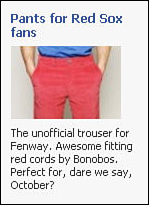
3. Take Advantage of Better Audience Data
Hypertargeting also enables greater iterating precision because campaign performance is broken down by audience segment. If an ad campaign fails, did it fail for everyone or only certain audience segments? Which audience segments resulted in the highest click-through rates and conversions? Advertisers can now get very granular about whom they’re showing what ads to, can continually test new ads, and can experiment with different ways of slicing and dicing their audience. Are males more responsive than females to an ad? Are these ads not working on people under age 20? What if the image and wording of the ad are altered? Hypertargeting gives advertisers more levers to test and optimize: location, gender, age, education, workplace, relationship status, relationship interests, and interest keywords.
Instead of having to optimize campaigns globally across all audience segments collectively, marketers can hypersegment, test, and iterate to optimize for each individual segment. Bonobos would develop different ads if it had to show everyone the same ad instead of being able to tailor ads for each segment. If advertisers are underperforming with a particular audience segment, they can focus on testing new messages with that segment, or even cut the segment from their campaigns, without affecting strategy elsewhere. This results in more optimal performance across the entire portfolio of campaigns—and no more weakest links.
Companies such as Bonobos are not only getting valuable feedback about ad campaigns, but they are also able to quickly learn which audiences are demanding their products and services. Demographic and psychographic information on social networking sites is helping companies better understand who their customers are beyond traditional purchase history information and prioritize limited resources across audience segments. Are high school students in the Midwest fanatical about clicking on your ads and buying your product? You could inadvertently have tapped into a bigger trend. Why not jump on the opportunity and concentrate your marketing efforts on this niche where you are seeing the greatest return?
The implications of these campaign insights reach far beyond marketing. Companies can use these insights to drive the overall strategy of the business, including decisions about research and development, sales, and operations—such as what kind of products to develop, which products to push through which channels, and where to locate inventory.
4. Cost-Effectively Reach Passive Buyers
Search advertising is effective because it catches people at the moment they are ready to buy. They have high intent, and the timing is right. But investing in search advertising alone can be expensive and can leave money on the table. It’s expensive because everyone else also wants to access a high-intent audience; for some keywords such as “real estate” and “casino,” advertisers have bid up prices to $50 per click. Yet money is left on the table because search advertising captures only a small portion of the total number of people you might want to advertise to.
Companies can realize value in showing ads to “passive buyers”—that is, people who aren’t proactively seeking out your product but who might be interested in buying it if they are encouraged. An offline example of passive buyers is people at the grocery store who make impulse purchases in the checkout aisle—such as gum, magazines, or gift cards. People might not have gone to the store expressly to buy a soda, but seeing the item (especially on sale) makes them realize they want it.
Especially for new, niche, or unknown products, search advertising might not make sense because your target audience probably doesn’t know that the product exists and, therefore, doesn’t know to search for it. Hypertargeted ads such as the one in Figure 6.5 can be an effective way to tap into latent demand in your target audience segments.
Figure 6.5
Little-known products such as this custom Stanford diploma frame are not good candidates for Google AdWords because most people might not even know to search for them. However, they can be a great fit for hypertargeted ads, such as this one for Stanford alumni.
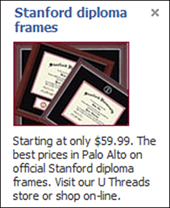
How do companies reach passive buyers? Display ads reach everyone, including passive buyers, but they are usually even more expensive than search advertising. There is less inventory because they tend to occupy dedicated ad slots. Because they don’t utilize targeting, display ads tend to overshoot (reaching audience segments for whom your product is irrelevant), resulting in wasted ad spend.
Not only are some impressions wasted on people unlikely to buy (similar to search advertising, described in the previous section), but these ads also suffer from low audience intent. It’s a double whammy. For example, a small start-up company such as Bonobos might not be able to afford display ads because too few people would find the ads relevant enough to click on. Traditionally, it made sense for only big brands to adopt the “spray-and-pray” approach of display ads. Fewer of their ads are wasted because they might appeal to a greater percentage of people viewing them.
But even the big-brand advertisers are demanding greater precision and better results. For them and other advertisers, hypertargeting might offer a cost-effective way to reach passive buyers and capture latent interest. By layering key demographic and psycho-graphic filters that correspond to their ideal customer profile, social network advertisers can capture latent demand without wasting ads on the wrong audience segments. They can access passive buyers without spending a fortune (see Figure 6.6).
This doesn’t imply that social network advertising will displace search engine marketing or display ads. On the contrary, the online social graph is already being used to make these models better. Facebook, LinkedIn, and MySpace all offer hypertargeted display advertising. It’s reasonable to expect that social networks will also try to incorporate search marketing sometime in the near future.
Figure 6.6
Hypertargeting enables advertising precision that can uncover latent interest from passive buyers and minimize wasted ad impressions. The result is a more optimal and better-performing ad campaign.
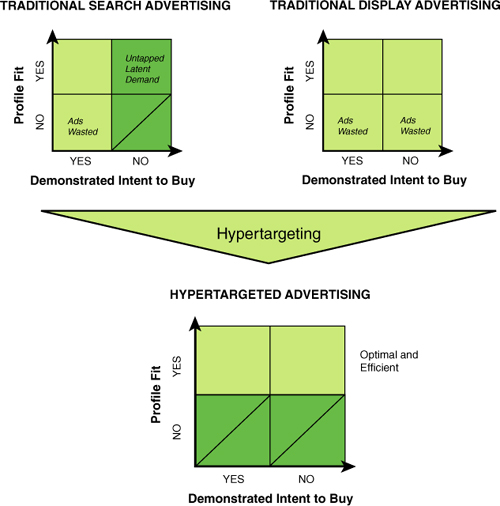
The following case study describes how Bonobos has used hypertargeting on Facebook to achieve impressive sales results.
Bonobos’ Success with Hypertargeting on Facebook
Bonobos is an innovative men’s clothing company started by two MBA students at the Stanford Graduate School of Business. Bonobos specializes in fashionable men’s pants in colorful styles that are available only online through its Web store. As a start-up company, Bonobos lacked brand awareness and distribution. But creative campaigns run through Facebook ads helped Bonobos overcome these hurdles and achieve a $2 million sales run rate less than one year after launching the company. According to CEO Andy Dunn, Facebook ads were the only form of advertising that was cost-efficient when Bonobos was just starting out.
Facebook’s targeting capabilities have given Bonobos greater control over ad development and optimization. By hypertargeting very specific audience segments by geography, college, and interests, the marketing team is able to quickly tailor, test, and optimize advertising messages while improving traction in new markets.
For example, July is summer in the Northern Hemisphere but winter in the Southern Hemisphere, so Bonobos targeted ads for shorts to American and European audiences and targeted ads for pants to Australian audiences. Another successful hypertargeted campaign previously mentioned promoted colored pants to fans that match their favorite sports team’s colors. For example, Bonobos shows ads for Nantucket red pants (the “Capertons”) to Facebook profiles in the Boston regional network who have “Red Sox” in their list of interests, and shows ads for orange pants (“Orange Crush”) to profiles in the Clemson University network. Hypertargeting has enabled Bonobos to expand the brand’s relevance and sphere of influence by relating to prospective customers in personal ways that are important to them.
The flexibility to start ad campaigns at any time of day has enabled Bonobos to successfully launch timely promotions that drive higher click-through rates and immediate sales. Returning to the sports team example, one time-sensitive ad strategy that worked particularly well was featuring pants that were “perfect for attending baseball games” as the baseball season was about to begin. Hypertargeted ads and timed ads have driven as much as 10% of Bonobos’ site traffic volume.
Social Distribution and Word-of-Mouth
Hypertargeting is a tremendous innovation, but it becomes even more powerful when you combine it with social distribution. Especially in today’s crowded marketplace—the average American is exposed to more than 3,000 advertising messages each day— social distribution from customer to customer instead of from vendor to customer is, by far, the most affordable and effective way for brands to stand out. Successful companies today don’t market to people. They market between people.
In Chapter 2, we talked about transitive trust. Not only is trust transitive—so are brand attention, enthusiasm, and loyalty. Customer X pays attention to and likes your product. Prospect Y pays attention to and likes Customer X. Suddenly, without you really having a say, you might find that Prospect Y also pays attention to and likes your product. Although these dynamics have existed all along, it was much harder and less efficient to convey brand affinity before the Facebook Era. Social network updates such as tweets and News Feed updates provide ideal channels to let people discover and engage. Because people choose whom to friend and follow on Facebook and Twitter, these sites are ideal platforms for word-of-mouth. Trust is inherent in the social graph of friend and follower relationships.
“Going viral” is the Holy Grail of marketing. The exciting news for marketers is that social sites seem to facilitate virality by making it easier for people to share content and experiences they love.
David King is an entrepreneur who is passionate about using digital media and the social Web for positive change in the world. In 2007, he began working on a project that led him to found Green Patch, Inc., which grew to be one of the largest social gaming companies on Facebook before Playdom acquired it. (Lil) Green Patch is one of the most viral games of all time. In the following guest expert sidebar, King gives some valuable advice on how to “go viral” by designing for social distribution.
Viral Design Lessons from the Social Gaming Industry
David King
Our (Lil) Green Patch game has touched more than 25 million users who tend to their virtual gardens, with a large number playing the game several times a day. Users send their friends plants, buy virtual good decorations, and tend to the (Lil) Green Patches that belong to friends.
The (Lil) Green Patch game uses positive actions in the virtual world to make a real impact in the world around us. We started a movement that raised more than $250,000 for The Nature Conservancy’s Adopt an Acre program to help save the rainforest on the Osa Peninsula of Costa Rica.
How did we touch so many people without investing in a marketing budget? It all comes down to virality.(Lil) Green Patch was primarily designed to be a viral experience. It was a decision that we debated about and reached agreement on early in the process. The (Lil) Green Patch game is practically impossible to play alone. Without your friends, you have a (Lil) Green Patch, but you have no plants to grow in it, no friend gardens to tend, and no ways to earn coins quickly. It’s a very boring game without friends involved.
The (Lil) Green Patch game has a simple message:Join with your friends to help change the world. The simplicity and collaborative aspect makes the social design compelling to users. When designing social software, it’s fundamental that the social interactions be the core of the design and the primary use of the software.
When designing social software, think about what the social graph enables. Can you instantly show interesting information about friends who are using the software so that the goodwill that users have toward friends enhances the quality of the first-time user experience of your product? Imagine beginning to use a new piece of software and finding that you already have 15 friends using it and you can see interesting things that they’re doing. Can you provide simple calls-to-action at meaningful and relevant touch points where users will want to either share a great experience or include additional friends to see how their information looks in your application? This is the path to virality.
David King (@deekay) is the founder of (Lil) Green Patch.
Lower Barriers to Sharing
Marketers have always known that recommendations and referrals from friends are powerful influencers in purchase decisions (see Figure 6.7). This means that your existing customers are valuable because they have the highest success rate for converting new customers. For marketers, social networking sites provide easy ways to broadcast recommendations to your existing customer base.
Figure 6.7
An eMarketer study in 2009 showed that “recommendations from people I know” is by far the most trusted source of information. A more recent survey by Edelman suggests that, perhaps because of social media fatigue, consumers are trusting friends less. Marketers must determine who is a good friend versus a weak tie.
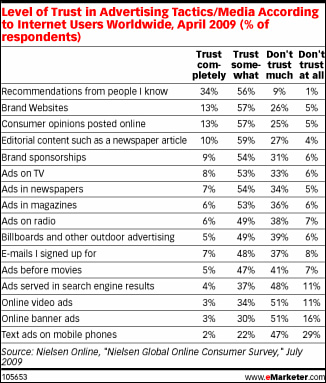
Before social networking sites, word-of-mouth marketing required people to be proactive about sharing and was pretty inefficient. People had to really love your product and also have the time to craft and deliver a message about it. A high bar was in place for what kinds of products got talked about—most products weren’t so lucky. Even when people did talk about your product, they might not have told very many people, to avoid the risk of annoying friends.
In contrast, real-time updates on the social Web have made word-of-mouth marketing easy and automatic. Every time people on Facebook update a status message, write on a Wall, send or receive a gift, RSVP for an event, make a comment, “like” a Page, or play a branded game, their friends find out.
When done right, marketers can tap into this effect to magnify the return on their campaigns and engagement initiatives. For every person marketers successfully engage on a social networking site, potentially dozens more can become engaged. The barriers to sharing have been lowered, so marketers of products and services that previously were not well suited for word-of-mouth marketing are suddenly finding that this method is driving significant growth.
Imagine that Ally “likes” (formerly known as becoming a fan of) Human Rights First, a nonprofit international human rights organization. Ally’s friends are instantly notified on their News Feed that she has “liked” Human Rights First, and they are also able to “like” the Page with one click in-line without leaving the News Feed page (see Figure 6.8).
Figure 6.8
Ally’s friends receive a notification in their Facebook News Feed that she “likes” the Facebook Page for Human Rights First (a nonprofit organization).
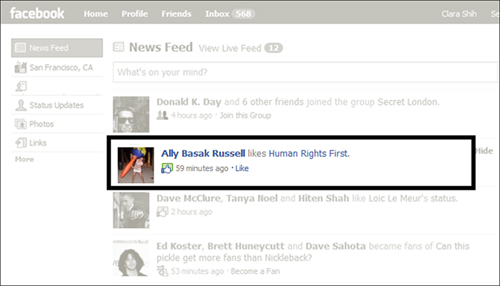
Anyone who visits Ally’s profile will see this also (see Figure 6.9). Without doing anything extra, Ally has become a word-of-mouth marketer for Human Rights First. Similarly, your customers do not have to proactively endorse your game, product, or organization. Facebook automatically broadcasts their affinities and decisions. Initially, these automatic behaviors were a shock for many users, but as we discussed in Chapter 2, activity feeds have become a largely accepted, and even wanted, feature of social applications.
Figure 6.9
Anyone who views Ally’s profile will also see that she has just “liked” Human Rights First.

Social Ads
In the previous example, Human Rights First benefited from free word-of-mouth advertising when Ally “liked” the Page, but the effect was temporary. Ally’s friends get notified only when she initially “likes” a Page or posts a comment on the Page Wall. Although the updates are passive on her part, News Feed updates about Ally and Humans Rights First are generated only when new activity occurs.
Social ads extend the life of these passive word-of-mouth messages by “reusing” fan information in ads. Essentially, Facebook’s advertising system uses Facebook Page fans as endorsers in the ad (see Figure 6.10). By associating an ad with a friend, brands can, in effect, tap into transitive trust and social capital between friends to win attention and engagement from new audience members.
Figure 6.10
Social ads on Facebook, such as this one that I created for The Facebook Era Business Page, mention any friends of the person viewing the ad who have already “liked” the Page. The idea is that people are more likely to click on an ad for something one of their friends likes.
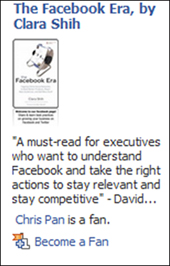
From the perspective of Facebook users, every time someone “likes” a Page, that person is implicitly providing consent to use his or her name and image to endorse the brand. The Facebook analytics team has an incredible amount of data about which users have the most influence and result in the most ad click-throughs. For example, they found that endorsements from women carry more weight with men. The advertising system incorporates a lot of this data to determine which of a Facebook Page’s fans to use to endorse to whom.
Reaching New Audiences
Even companies flush with cash find it extremely difficult to enter new markets. Not only can it be prohibitively expensive, but it’s also full of many unknowns, such as which new market is the best one to go after.
Word-of-mouth that happens across social networks can often help companies “accidentally” discover new audiences and fan bases. By tapping the existing connections between individuals that cut across different homogeneous networks, such as region (see Figure 6.11), age, and industry, companies can extend their spheres of influence to new, sometimes unexpected markets and reach new pockets of people.
Figure 6.11
Ex–Apple engineer Pete Warden has done groundbreaking analyses and visualizations of Facebook connections across different cross-sections, including regional networks. As this visualization shows, although the majority of friend connections exist within regions, a substantial number of connections also bridge disparate regions.
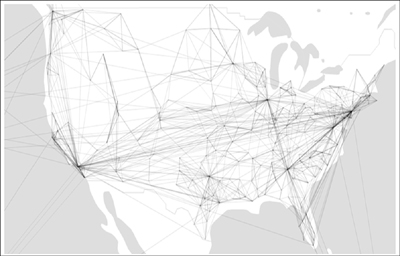
For example, Barack Obama’s 2008 presidential campaign used Facebook to recruit unlikely supporters among low-wage, blue-collar workers in Harrison County, Indiana—historically, a very Republican region of the country. At the time, Obama’s TV ads didn’t seem to be effective. Many campaign staffers wanted to write off this part of the state entirely. But Obama supporters elsewhere who had ties to people living in Harrison County started using Facebook to rally the locals around Obama’s cause. Before long, a contingent of Harrison County residents were helping lead national phone-banking efforts and contributing to the campaign. Obama narrowly won Indiana in the general election.
Social Shopping and Recommendations
As business on the social Web matures, friend actions and recommendations are reaching beyond brand awareness and pervading the shopping experience itself. Shopping is an inherently social activity—we ask some friends how we look in a pair of jeans and other friends which camera to buy. Review sites such as Amazon, Yelp, and Epinions have been tremendously helpful. But what consumers want now goes beyond recommendations from strangers; they want recommendations from friends, and often a different set of friends for different items. (For example, you might ask a different person about the jeans than you would about the digital camera.)
Although we are likely still a few years away from social shopping becoming mainstream, exciting developments are already taking shape, both as Facebook commerce applications and as Facebook for Websites integrations on shopping sites. I don’t go into exhaustive detail here—because that’s beyond the scope of this book and also because I don’t have much to share, given how nascent social commerce is—but I can share some early examples.
One of the Facebook commerce applications that has been around the longest comes from Pizza Hut, which we introduced in Chapter 1, “The Fourth Revolution.” It enables you to order pizza without leaving Facebook. You even have the option to have the app post a News Feed update to your friends about your order. It’s not perfect—you still have to sign up for a login with Pizza Hut and type in your address—but it’s likely the direction we are headed. Especially as Facebook begins privately storing more physical addresses of its users, the shopping, ordering, and delivery experience will become even smoother and more common.
Don’t worry, you don’t have to build everything on your own from scratch. An easy way for retailers to start creating a shopping experience on Facebook is to go with ecommerce and payment vendors such as Payvment and Alvenda. Facebook itself has developed a payments system that enables people to buy Facebook “credits” using a credit card, and then to spend the credits on applications that are using Facebook’s payment system, including Facebook gifts. Currently, Facebook charges 30% of revenue for use of its payment system (similar to what Apple’s AppStore does).
Another option is to do what Best Buy has done: Bring your product catalog onto Facebook so people can browse, share with their friends, and make the decision to purchase within a social environment—and then the moment they are ready to buy, open a window to your existing ecommerce flow. This is certainly a lot easier than re-creating the entire shopping experience end-to-end within Facebook, but it still provides benefits of a social shopping experience.
No matter how successful Facebook continues to be, many commerce transactions and shopping experiences will continue to take place off Facebook. Implementing Facebook for Websites (introduced at the end of Chapter 1) on external commerce sites enables companies to bring the social experience to shopping (versus the previous examples, in which companies are bringing shopping to the social experience). For example, flyers on Virgin America can log in with their Facebook credentials to seek and book the same flights as their friends.
Many people think that the ultimate social shopping experience would emerge if Amazon or eBay integrated with Facebook for Websites. Groupon has done this, and it has experienced phenomenal growth. Groupon strikes volume deals with local businesses, such as spas, restaurants, and shows. Members can purchase gift cards and tickets at a steep discount, and they have built-in incentives to invite their friends to do the same, given the social nature of many of these activities, such as going out to dinner or visiting the zoo.
Promoting Events
The social Web is also extremely powerful for events. One of my favorite examples is Live Nation (which also owns Ticketmaster) implementing Facebook for Websites on its Web site. Concertgoers can log in to the site with Facebook credentials to discover which concerts their friends are going to. The Live Stream widget (get it from http://facebook.com/ facebook-widgets) then enables Facebook users to connect, share, and post updates in real time on their Facebook Page or external Web site that has implemented Facebook for Websites.
In the conference world, Web 2.0 Expo is one of the most successful technology events in the industry, drawing thousands of people from around the world each year to its shows in San Francisco and New York. It features the latest Web 2.0 business models, development paradigms, and design strategies. In the following guest expert sidebar, Expo chair Brady Forrest shares some practical advice on how to promote events on the social Web.
Promoting Events on Facebook and Twitter
Brady Forrest
The events business is all about community. If your communities leave or forget you, then you are out of business. You have to consider each of their needs and give them something that makes them want to be at an event instead of just reading about it later. You can use Twitter and Facebook to help with this before, during, and after the event using these tips:
• Be there—You need to be present on social media networks. Create a Twitter account and Facebook Page for the event that people can follow or fan. Use Twitter’s List feature to put all the accounts into one place.
• Create connections—The number one reason people go to events is to meet people—so help them do this. If you’re looking for a new employee, use Twitter and Facebook to spread the word. If you’re going down the street for drinks, let others know. Doing so will make the event more memorable, useful, and, ultimately, well regarded.
• Promote your attendees—If someone shares an insight that they learned at the conference, help them spread it. Suddenly more people will start sharing their thoughts on the event with the hope that they’ll be recognized (and you should retweet some of those, too). Use the Twitter Lists feature to create groups of attendees.
• Share the event (and make it easy for attendees to do so, too)—Talk about the event. Write about the event beforehand. Announce when you sign up speakers. Offer discounts. Give people a reason to pay attention to you before the event happens. Then during the event, you want to be the news source. You want people who aren’t there to be curious about what is happening now and what will happen. You want attendees to know the coolest thing that is happening right now. If you’ve done your job right, the attendees know the hashtags and are doing half the work for you.
• Don’t stop—Your social media accounts should be staffed year-round. You should all use the same hashtags, and you should make sure your attendees know what they are.
Brady Forrest (@brady) is the cochair of Web 2.0 Expo and cocreator of Ignite.
Engagement Is King
In addition to hypertargeting and social distribution, marketing is shifting from being tactical and transaction-oriented to more strategic and embedded in experience.
Marketing for the Long Term
Before the Facebook Era, online marketing was about optimizing for the transaction— that is, open rates, click-throughs, and conversions. We did this because we had to—no other data was available.
The social Web has changed all this. For the first time, companies can capture not just the customer transaction, but also the customer relationship. Through fans and followers, organizations can now confidently invest in “upper funnel” activities—that is, driving more casual interest in their products and services without pressuring the commitment of a purchase transaction. Relationship marketing in the Facebook Era lets companies take a longer-term view of the business, optimizing for lifetime relationships and loyalty tomorrow instead of a single transaction today.
The most successful companies on the social Web are not constantly pushing their products and promotions; instead, they are investing in building their sphere of influence in their business area. In the following sidebar, marketing and branding expert Brian Solis explains the value of engaging audiences with content.
In Social Media, Brands Become Media
Brian Solis
One of the greatest challenges new media champions encounter today is not the willingness of a brand to engage, but its capability to create. When blueprinting a social media strategy, enthusiasm and support usually diminish when faced with the dedication of the resources and commitment required to produce regular and engaging content.
The democratization of publishing and the equalization of influence enable us to create and connect with a wider reach. Everything starts with a mission and is fortified by the content we create. Therefore, we not only become our media—through production and engagement—but we can become influential.
Although establishing a presence is elementary, captivating audiences is artful. In the near future, brands and organizations will create new roles or augment existing roles for editors and publishers to create timely, relevant, and captivating content on all social media channels. This work is in addition to the other reactive and proactive social media campaigns that are already in progress. A strategic editorial calendar should blend video, audio, imagery, text, updates, and other social objects and networks to reach, inspire, and galvanize communities.
As media, brands earn prominence and, hopefully, influence as rewards for contributing meaningful content. On Twitter, brands can earn legions of loyal and responsive followers. They, in turn, become brand advocates and ambassadors, extending the messages, mission, and purpose of the brand to their followers as well. On Facebook, brands can cultivate vibrant and dedicated communities in which interaction inspires increased responses—each reverberating across new social graphs. On Ustream and YouTube, we can earn global audiences of viewers who tune in to watch our programming and interact with brand representatives in a live community that spills into other social networks. And, of course, our blog is more important than we might realize. Through our posts, we can establish a strong alliance of subscribers who hope to learn new things and participate in the discussion of a brand’s future.
We now have the capability to earn noteworthy, equal, and, in some cases, greater influence than those authorities we’ve relied on to help us reach greater audiences and communities. As influence is equalized, our capability to earn presence and relationships is derived from how we program, manage, and participate across the social Web. In essence, brands of tomorrow will become media.
Brian Solis (@briansolis) is the principal of FutureWorks and the author of Engage: The Complete Guide for Brands and Businesses to Build, Cultivate, and Measure Success in the New Web (Wiley, 2010).
Embedded Marketing and Appvertising
Companies are also discovering that it’s often more effective to engage people with applications instead of trying to get them to click on ads, which can be distracting. This embedded marketing strategy on social networking sites is similar to product placement in a TV show versus advertising during the commercial break.
The idea is that people are more likely to engage when your message is embedded in the context of what they are already doing—such as reading their News Feed, playing a game, or socializing with a friend. Otherwise, it can be pretty disruptive for people to stop what they’re doing, click on an ad that loads up your Web site, and read your landing page. This is why most people don’t usually click on ads. When your ad shows up, they were in the middle of doing something else. So they tune it out, similar to switching channels or fast-forwarding through a TV commercial.
Compared to other social networking sites, Facebook has the most developed set of options for embedded marketing. Facebook itself offers what it calls engagement ads for brand advertisers to reach people on the Facebook home page. These are interactive ad units for people to “like” something on Facebook (refer to Figure 6.10), view and comment on videos, respond to polls, send sponsored virtual gifts, or RSVP for events without having to leave the Web page. We discuss these engagement ads in Chapter 12, “How To: Advertise and Promote on the Social Web.”
Minimum campaign spending thresholds (around $50,000) on Facebook engagement ads generally preclude everybody but the big-brand advertisers from taking part. Advertising, sponsorship, or branding of Facebook platform applications, or appvertising, is another form of embedded marketing that is open potentially to anyone. If Facebook engagement ads are similar to product placement, then appvertising is similar to creating your own TV show and experience. (Note that I don’t cover Twitter or LinkedIn here because you can’t really embed applications inside the Twitter experience, and only a handful of select approved partners are able to do so on LinkedIn.)
Apps tend to be more active and engaging than ad clicks and impressions, but they also take a lot more work to put together. As a marketer, you have three options when it comes to platform apps: build it yourself, commission someone to build it for you, or sponsor an existing app.
• Build it yourself—This is likely the hardest option for most companies, unless you have a staff of developers on hand. But depending on your budget and requirements, you might not have a choice but to try it yourself. Companies such as Sprout and Transpond have developed fantastic point-and-click app-development platforms that make it a lot easier (see Figure 6.12).
Figure 6.12
Sprout Builder is a Photoshop-like environment for developing interactive widgets and applications.
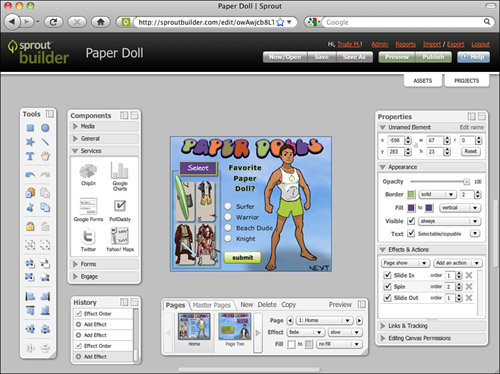
• Commission a custom application—A growing number of digital agencies now provide custom Facebook app-development services. Dedicated Facebook app-development companies, such as Context Optional, Buddy Media, and All Widgets, provide custom-branded application-building services. For example, Microsoft commissioned Context Optional to change brand perception and drive awareness for its most recent version of Microsoft Office. The resulting application was Office Poke!, a play off Facebook pokes that enables users to throw staplers, steal chairs, and, of course, upgrade their machine to Office 2007 (see Figure 6.13). Office Poke! resulted in more than 4 million branded pokes sent in the first 60 days of the campaign.
Figure 6.13
Facebook app-development company Context Optional created this custom Office Poke! application for Microsoft.
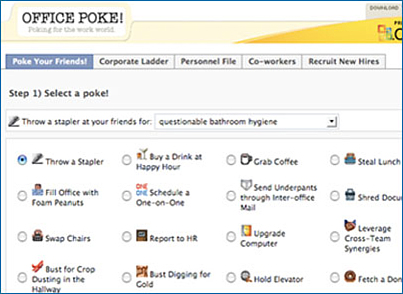
• Sponsor an existing app—Despite some successes with custom-developed applications, most companies are finding it difficult to know which apps will take off and are unwilling to spend the time and money on something that might fail. Instead, marketers are choosing to sponsor apps that are already successful. Marketers work directly with application developers to sponsor or advertise an app, or they advertise on ad networks such as Adknowledge and Rocketfuel that serve ads to these applications. For example, American Family Insurance decided to sponsor a popular Facebook application, FamilyLink, that has nearly 18 million monthly active users, instead of trying to build its own application (see Figure 6.14).
Figure 6.14
American Family Insurance sponsors FamilyLink pages such as this one that enables people to organize and celebrate important milestones of a new baby, new home, or graduation. American Family Insurance provides site content about family safety, home maintenance, and family protection.
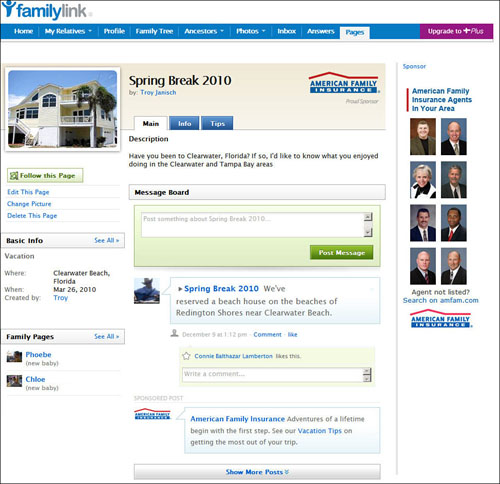
Early in the Facebook Era, a number of companies, including Offerpal and Super Rewards, developed platforms for creating special offers. For example, Facebook users could receive special status or points for use in games by filling out lead-generation offers, such as signing up for a trial of Netflix to get $49,280 in virtual Texas HoldEm poker chips (see Figure 6.15). Although this was a good deal for users (they opted in to do this), advertisers soon realized that these leads were not very good. People filling out the offer form had no interest in Netflix—they just wanted to get some more poker chips for free. After a searing blog post by Michael Arrington of TechCrunch in fall 2009 about social gaming lead-generation scams, a number of these companies have taken a step back and pledged to rethink their special offers.
Figure 6.15
Before November 2009, Zynga’s Texas HoldEm Poker app let players earn virtual poker chips by completing special offers from sponsors such as Netflix, Free Scholarships for School, Columbia House DVD Club, and Jamster Ringtones. The problem was that people weren’t actually interested in these products—they just wanted more poker chips.

Challenges and Limitations
We are still in the early days of social network marketing. Tremendous opportunities and possibilities exist, but so do serious challenges and limitations. Yes, Facebook advertising is precise, personal, and social—but so what? Some progress has been made, but poor brand fit, poor performance, social network fatigue, adjacency to questionable content, and negative buzz are real problems that need to be considered and addressed.
Poor Brand Fit
In many situations, social network marketing doesn’t make sense because people don’t want to broadcast their affinity for your product. Success often depends on two factors: the product and the site demographic.
Certain product and brand categories—such as sports, recreation, politics, movies, books, food, clothing, and celebrities—are ideal because they evoke passion and individuals use them to express themselves. Products that might be less exciting, more commoditized, embarrassing, and either too personal or too impersonal—such as laundry detergent, medication, and office supplies—are generally less of a good fit. Similarly, luxury items such as high-end cars or jewelry might feel like bragging.
As a company considering a presence on social networking sites, the best thing you can do is to guide your brand in a direction that is exciting but credible. Position your product to stand for something, and customers will want to stand behind it.
Poor Performance
Ad performance on Facebook and LinkedIn has been pretty bad—on average, one-tenth or less of the click-through rate on search ads. However, average CPM bids tend to be much lower on social networking sites. No one has completely figured out how to overcome low purchase intent on social networking sites. I expect that this will change over time. First, Facebook will probably add more search and ecommerce functionality. Second, a logical next step would be for Facebook for Websites to provide AdSense-like social ad syndication to partner sites, including search, shopping, and ecommerce sites.
In the meantime, the best advice is to start small and simple, and set realistic expectations. Just as slapping up a Web site and buying AdWords doesn’t automatically transform businesses into a success, effective social network marketing requires strategy, testing, and iteration. Chapter 12 goes into detail on how to optimize click-throughs and conversions with social network ads.
Social Network Fatigue
One concern about social network marketing is that people are starting to tire of Facebook and Twitter, similar to how they tired of Friendster. Only time will tell whether people continue to sign up and log in after the novelty wears off.
Fatigue is also occurring with social ads. Some social network members are already beginning to complain that the sites feel too commercial. One danger is that people could get turned off if their experience on social networking sites becomes too inundated with ads and stops being about them and their friends. The social networks will need to balance pursuing monetization efforts against keeping people happy and engaged.
This concern was a large motivation behind Facebook’s decision to create Business Pages and, more recently, Community Pages that are distinct from individual profiles. Having this clear distinction enables Facebook to create separate privacy models for individuals versus organizational entities, and also lets individuals keep these two worlds separate whenever and however they want.
Adjacency to Questionable Content
One challenge advertisers face with any type of social media is adjacent placement to questionable user-generated content, such as a sexually explicit MySpace profile page. For example, a brand might not want to be associated with a particular political group or controversial celebrity.
The social networks are starting to explore ways to give advertisers more control over where their ads appear. For example, Facebook enables advertisers in the United Kingdom to opt out of ad placement next to all Facebook Groups.
Negative Buzz
The risk in empowering users to define and spread brand messages is that these messages might not always be positive, and brands might have very little control over the aftermath. Many believe the 2005 movie King Kong failed to meet expectations at the box office because negative word-of-mouth that it was “too long, too loud, and overdone” caused many people to not even give it a chance. The Segway scooter is another example of a product that generated a lot of buzz from word-of-mouth, but it was mostly negative. A reputation of being “funny looking” and “dangerous on sidewalks” did not help sales.
People are having brand conversations whether you are even aware of them. It’s better to try to facilitate where it makes sense, reward and provide channels for your advocates, and address feedback from the community than to not do anything.
In our age of information and transparency, people will talk about your product. The only difference when these conversations occur on social networking sites is that brands gain visibility and have the chance to respond. Instead of turning a blind eye, companies should welcome and respond to feedback from the community. Ultimately, this is real and valuable feedback that could improve your product or service in ways you might never have considered.
![]() Many social networking sites now offer hypertargeting, the capability for companies to target ads and messages to people based on their profile information.
Many social networking sites now offer hypertargeting, the capability for companies to target ads and messages to people based on their profile information.
![]() Hypertargeted ads that are about the friends, places, and issues important to your target customer are far more effective than ads about your company.
Hypertargeted ads that are about the friends, places, and issues important to your target customer are far more effective than ads about your company.
![]() With hypertargeting, you don’t have to be a big-brand advertiser with a multimillion-dollar budget to capture latent demand. By honing in on key audience segments with highly tailored messaging, companies of any size can cost-effectively run brand campaigns.
With hypertargeting, you don’t have to be a big-brand advertiser with a multimillion-dollar budget to capture latent demand. By honing in on key audience segments with highly tailored messaging, companies of any size can cost-effectively run brand campaigns.
![]() When someone becomes a fan or follower, you’ve won over not only that person, but potentially also a subset of that person’s friends and followers.
When someone becomes a fan or follower, you’ve won over not only that person, but potentially also a subset of that person’s friends and followers.
![]() The biggest challenges to Facebook marketing are poor brand fit, poor performance, social network fatigue, adjacency to questionable content, and negative buzz.
The biggest challenges to Facebook marketing are poor brand fit, poor performance, social network fatigue, adjacency to questionable content, and negative buzz.
> > > TIPS and TO DO’s
![]() Tailor your ad copy based on the hypertargeting criteria you select in the campaign, as companies like Bonobos have done in appealing to sports fans with their clothing ads.
Tailor your ad copy based on the hypertargeting criteria you select in the campaign, as companies like Bonobos have done in appealing to sports fans with their clothing ads.
![]() Bid different CPC or CPM based on audience value, including expected customer lifetime value and empirical conversion rates.
Bid different CPC or CPM based on audience value, including expected customer lifetime value and empirical conversion rates.
![]() If you are looking to maximize campaign reach, consider sponsoring or advertising within an already-popular application that a third party has created.
If you are looking to maximize campaign reach, consider sponsoring or advertising within an already-popular application that a third party has created.
![]() If you are looking to maximize engagement within your existing base, consider building your own custom application and make it available on your Facebook Page.
If you are looking to maximize engagement within your existing base, consider building your own custom application and make it available on your Facebook Page.
![]() Use hypertargeting as a cheap way to test receptiveness of new markets to your products and services.
Use hypertargeting as a cheap way to test receptiveness of new markets to your products and services.
